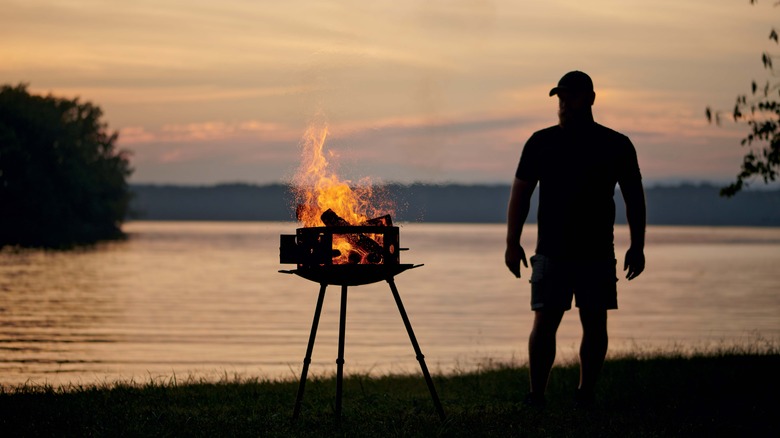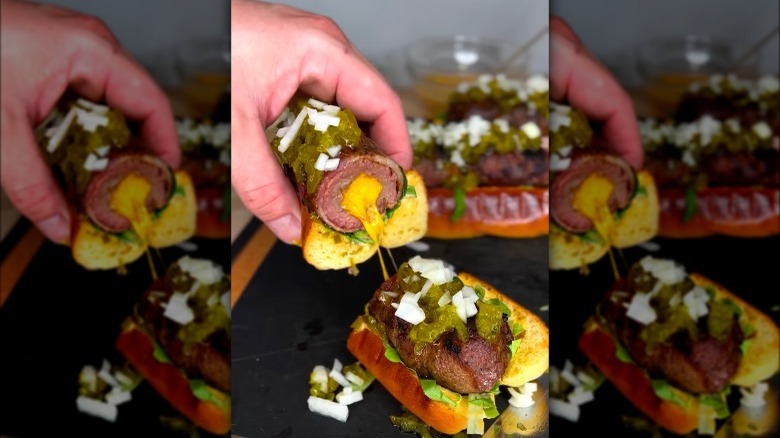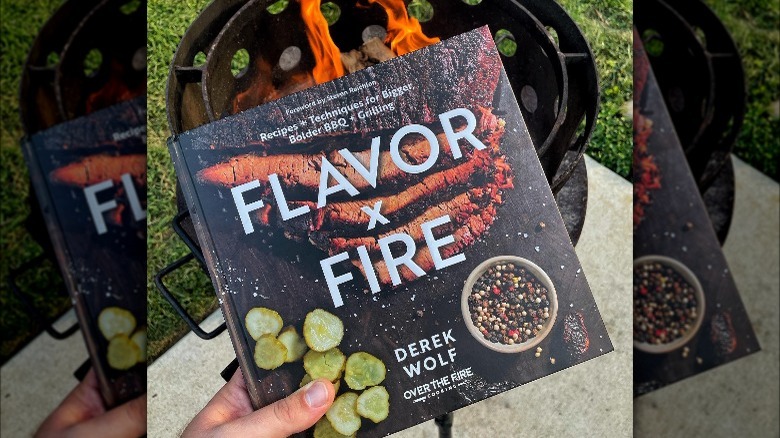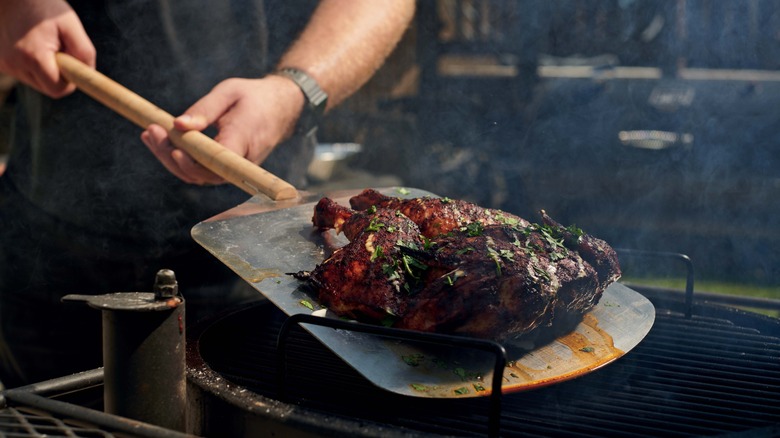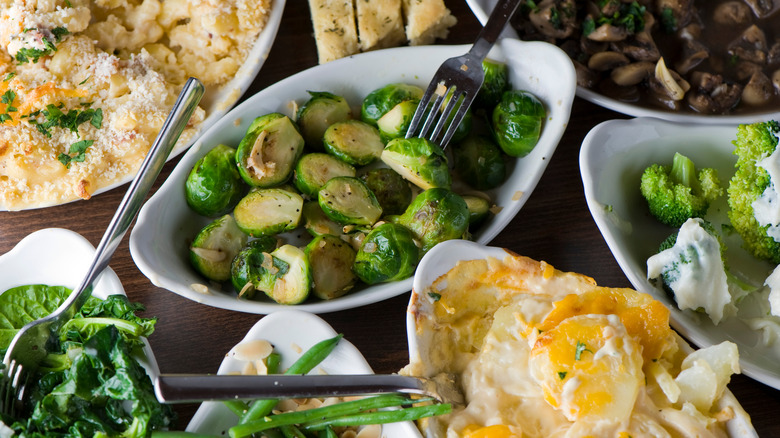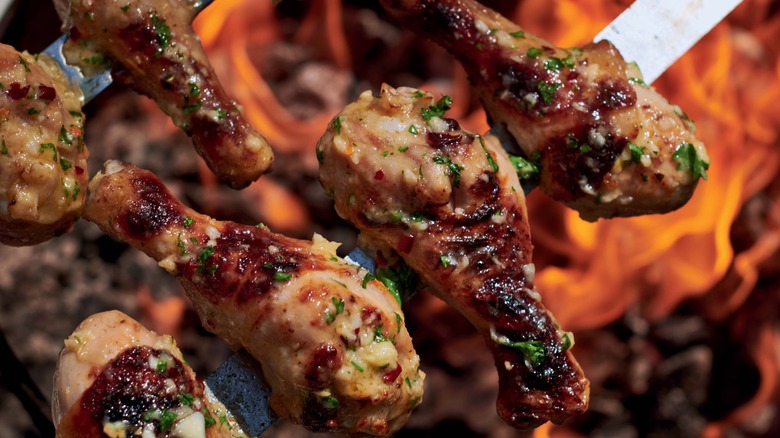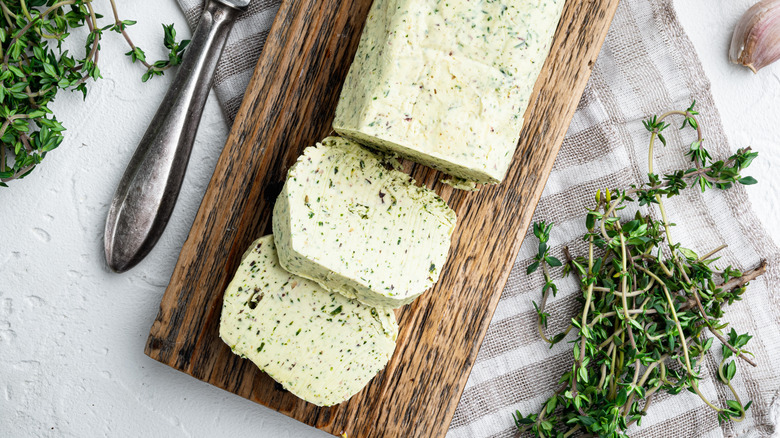Derek Wolf From Over The Fire Cooking Talks Grilling Tips And Myths - Exclusive Interview
Barbecue season is in full swing, which means it's the perfect time to spark up the backyard grill. If you wouldn't classify yourself as a cookout connoisseur, don't fret. Derek Wolf, the founder of Over The Fire Cooking, knows how to handle all of your smoked-kissed meat and vegetable needs. After creating a social media empire (the Over The Fire Cooking Instagram is at 2.2 million followers and counting), Wolf expanded to the world of print in 2021 with "Food by Fire." He's bringing the heat again with his follow-up book "Flavor by Fire." This time around, Wolf offers a deeper dive into all things grilling and barbecue, sharing plenty of tips, tricks, and mouthwatering recipes.
During an exclusive interview with Tasting Table, Wolf shared his unique perspective on outdoor cooking, offering his advice on under-the-radar meat cuts, naming his favorite recipes from "Flavor by Fire," and busting the most common grilling myths. If you want to take your grilling skills to the next level, read on!
How Derek Wolf became a social media star
How did you get started creating recipe videos for social media?
I started Over the Fire about six years ago in September. I was working in a corporate job and I needed a break on the weekend, something that made me feel inspired. And so when I first got on social media, I was super reluctant and wasn't really confident in my cooking skills. I have no background in food or anything, so I was just really inspired to share things that inspired me on social media. And so I started the page, and then on the weekends I would just cook as much as I could, and then I saw that there was an opportunity for these one-minute style recipe videos in the barbecue space. And so I just started doing them for fun, and it just exploded.
So that was about six, seven months into it. And we started getting more consistent with them. I left my job about a year into doing Over the Fire, and honestly, the rest has been history. It's just been slow, consistent growth. And then just trying to keep up with all of the new everything, socials, whatever it is. And so then went full time about five years ago. My wife is now full-time with me. She's been doing that for two years. And we have a team of about five people.
Is there a popular recipe that your followers have responded to the most?
Gosh, I think the recipes that I tend to do that have garnered the most attention tend to be the ones that have pushed the boundaries of food a little bit. So since I was not a chef I was willing to break unwritten food rules such as putting cheese on seafood, skewering sausages ... doing things that would push the boundaries. And every once in a while I would say things, just my own personal opinions that I knew would just rile people up like pineapple doesn't belong on pizza or those kinds of things. Even though I grew up with a family that ate pineapple on pizza, I personally don't like it.
I would capture their attention by doing something that would maybe make them upset for a moment. But then I would bring them back in with what I did with the food itself. So a lot of it has been that. And then honestly, I've had a lot of videos go really far, but I don't know if there's been one video that has just blown it out of the water, or at least one recipe. But most of them are pretty open fire related. I really love taking the concept of, what you can do in the kitchen I can do over open flame. But we tend to, obviously, focus on meat-heavy [dishes], and I do a lot more on sauces. And we're working on doing more sides and stuff like that as well.
Derek Wolf talks about his popular Big Mac Dog recipe
So I was looking at your YouTube channel, and I saw an interesting recipe for the Big Mac Dog. What inspired this recipe, and was there any experimentation behind the dish to get to the final Big Mac Dog recipe?
Yeah, so that recipe, hilariously enough ... so I have five people that work for me. One of them is named Jeremy Whitelaw. He runs an account called The Kitchen Whitelaw, and he is a recipe writer for me. And so I developed a recipe, he added a couple, a few little twists, and then he cooked it, because I just don't have time all the time. I'd been toying with the idea of "how I can make hot dogs better?" And I think hot dogs are hard to make gourmet, and people treat them as gourmet.
And so a couple weeks prior I had made these stuffed chorizo dogs. It was Monterey Jack cheese wrapped in a similar way with ground chorizo, and then wrapped in bacon. Then I topped it off with a cilantro lime mayo and some cilantro and onion. And I kind of made it like a "dog." And so I jokingly said to him on a phone call, our weekly phone call, I was like, "It'd be funny if we could make a Big Mac dog, or something. And he just went for it. And so he's traditionally a baker.
So he made the buns, and I even learned from him, too. One of the issues I tend to have with those is keeping the bacon and the cheese tight so that the cheese isn't spilling out. And so he did it like a roulade, very classic French style, where he made it the night before and then he wrapped it really tight in cellophane. Then he put it in the fridge, and then it just firmed together a lot stronger so that when you're grilling it, because it's beef, you can grill it really hot and fast over the grill and get that bacon really crispy. He finished it off with the classic sauce, the Big Mac sauce, the onions, and the whole nine yards. So that was a really fun one.
The inspiration behind Derek Wolf's new cookbook
What can fans expect from your upcoming book, "Flavor by Fire?"
So the first book was trying to teach people how to cook with fire. This next one is using all the steps that we learned with cooking with fire — same verbiage, in the process. And then let's dive into what we can do to amplify the food with both its flavor in ingredients and its flavor using the fire. So I think that we do it in multiple ways. I dive into the different tastes and talk through some of those, and then how we can use those to be complimentary.
And then dive into what encompasses flavor itself, and then how flavor utilizes the taste, and then it utilizes the temperature, it utilizes the experience around things. And I think that we also are able to mold it through the fire itself, so you can get different flavors off the fire. You can get a bitter flavor from grilling it directly hot and fast and getting that heat reaction really hot. You can also get a smokey, savory flavor, obviously traditional to Southeast barbecue. So I take an intro step into teaching people how they can utilize the fire and the smoke to amplify flavor.
If you could pick a favorite recipe from the book, what would it be?
I have a few that I love. I got really deep into bone marrow for a long time, and I thought that was really fun. So I have a black garlic New York strip with bone marrow butter. It's a play off of salt, pepper, and garlic. So salt, pepper, and garlic is a classic steak seasoning, but I use black garlic instead. So you kind of get this subtly funky flavor, almost similar to dry-aged steak. And then the bone marrow. It looks really funky, but really, it's just like beef butter, so it just makes the beef flavor even more intense. I think that's one of my favorites. I tend to be a beef, seafood, and a chicken kind of guy.
I don't really love pork, but I'm pretty proud of my pork chapter. And so I made this cocoa molasses-glazed spiral ham because one of the struggles I have with ham is that it tends to be paired with really, really sweet kind of flavors — pineapple, maraschino cherries. You've seen the classic Dr. Seuss hams with the pineapple slices and the cherries stuffed into it. I wanted to go for something that amplified a little bitter flavor coming off of it, because I mean, pork is a little bit sweeter, it has an inherently sweeter flavor. And so I went a little darker, and honestly, it's probably one of the best recipes out of the whole cookbook. Dark chocolate is actually very bitter. So we're amplifying that bitterness with a slight hint of sweet, but toning it back. And then the molasses is also, in a similar way, it's still sweet, a lot more sweet than cocoa, but I think that combining those flavors helped to mildly make ham less salty and sweet.
Derek Wolf reveals his best grilling hack and favorite budget steaks
What is your best grilling hack?
Well, I've got a few. So I'm cooking with a high heat all the time. I get asked all the time, what gloves do I use when I'm cooking? And high heat welding gloves are the greatest little tidbit that makes a huge difference. They go up to like 970 F so I can pick up burning logs and move them. And when cooking with fire, sometimes, unlike the kitchen, I actually have the ability to move the fire. And so if I need to lower heat, or lower anything, or heighten heat, I can move the logs themselves instead of trying to move my grill. I think that makes a big difference.
Do you have a favorite, under-the-radar, cut of meat or vegetable to grill?
Yeah. So I got a few. I think that, for the three major steaks that are out there that everybody knows, so there's New York strip, there's ribeye, and then there is filet mignon — they're getting more expensive. And so I think that there are other steaks that represent them well, that are a little cheaper. Now, I can't say they're as cheap as they used to be, but people are starting to find them.
For filet mignon, teres major is a butcher cut. It's a lot smaller but is just as tender and actually has a little bit more fat. So I really like that one. Chuck ribeyes are a lot cheaper. They don't actually come from the chuck, they just come from the chuck end side of the ribeye. And I mean, they're not as easy to find because a lot of the butchers usually take them. So if you can snag one of those, infinitely cheaper than ribeye, it still gives you the spinalis that you're looking for, like the top half is the super tender part, but has a lot of meat on it.
And then if you love New York strips like myself ... picanha is a top sirloin cap, so it comes basically right off the top of the cow's butt. And it's got a thick fat cap on it. You might have seen it if you've ever been to a Brazilian restaurant and they serve you big skewers with the C-shaped steaks. So it's like a big C. They always show them on all of the promos. That's picanha. If you can trim some of the fat off of that and serve it up, it's very, very, very similar to a New York strip.
Why Derek Wolf always eats the sides first at a steakhouse
So what is your biggest tip when cooking vegetables on the grill or smoker?
Take your time. I think a lot of people want to cook them hot and fast, get it done, because it's usually what they are doing the last, or first, they just want to get to cooking the meat. I think, give your vegetables the time and dedication that they deserve, because honestly, funny enough, I think that when I go to a steakhouse, or grilling with somebody, I will usually try their sides first before I get into the steak, because in my opinion if they treat their sides with respect, they're going to treat their meat with respect. So if their sides have a good flavor, then nine times out of 10, their steaks do as well.
Yeah. That makes a lot of sense. What is the best griller, smoker to buy for beginners who are looking to get into it?
Oh gosh. I mean, it really just depends on the price point. I work with Oklahoma Joe. I really do think that Oklahoma Joe ... they have a drum smoker. So it's a standup smoker, it's not a horizontal smoker. It is a lot easier for people to process how the heat is flowing. So it's obviously coming up from the bottom, and then it'll have what they call a "diffuser plate." So it's just this big plate with some air holes around it. And really, all that's doing is retaining the heat below so that you can cook at a lower temperature above.
So people see it more similar to their Weber kettles or their gas grills. I think it's a really great intro into barbecue and smoking. I think that it's easier to process, it's easier for people to keep clean — overall, probably my favorite when it comes to that. I really think that when it comes to a grill or anything like that, I mean, any kettle is a really great place to start if they want to get into charcoal grilling. If you're going to start in open fire cooking, I would start with charcoal before you really jump into real wood. Charcoal's just going to have a little bit more control over the temperature. And it's just going to give you a lot more ability to fine-tune your cooking skill. Real wood, there are a lot of other factors that come into play: how dry the wood is, what's your outside temperature, what's the wind speed. A lot of things come into understanding how to cook over an open flame.
Derek Wolf debunks some popular grilling myths
Is there one common grilling mistake or myth that you stumble upon all of the time and it's just not true?
Yeah. There's quite a few. So I'll give you three of them, because I'm very passionate about three of them. So first one, please, for the love of all that is good don't wash your food. When it comes to raw meat, you don't need to wash your meat. You're welcome to do it. But theoretically, you're cooking the bacteria out when you cook it, you're getting rid of it when you cook it. Especially chicken. And a lot of the times when you quote, wash it, even if you're rinsing it under water, you run more risk of bacteria splashing out and getting on your countertops or anything like that than you do if you just baked it and be done with it.
Another one is: Letting your steak come to room temperature doesn't necessarily work. I think there's a lot of food science out there that's showing that a lot of people let it sit for an hour out in their kitchen before they cook. While I do think that there might be a noticeable difference in your sear, I think that has the internal temperature ... Kenji Lopez-Alt actually has a great article about this. The internal temperature doesn't change much more than maybe five degrees. So you're not really thawing your steak.
Right. So you put it in the fridge from the freezer and then take it out from there?
Usually, I'll let it sit for maybe five-ish minutes just to warm up, and then I'm going right onto the grill. I think it is more of a food safety issue, at that point is, five, 10 minutes or so, but after that, you run the risk of bacteria developing.
I think that's a big one. And then another one is there is no wrong way to make food. I think that you can get hit on by a lot of people that are saying you're doing it wrong. I'll add all kinds of seasonings to my steak and I'll get hit by every 40-year-old to 50-year-old white man that grills on their grill and says that I did it wrong because I did anything more than salt and pepper, or even just salt. And I think that I struggle with that because every "traditional" food that we've ever had was at one point non-traditional.
And so I think that pushing the boundaries and thinking outside the box is always hard for anybody, especially when we get comfortable with food. But I think that's a big thing that I wanted to do in this cookbook, and what I do on a weekly basis with my recipes is how can I amplify food and flavor and think outside the box and how I'm supposed to cook it. I have a lot of chefs that are like, you're never supposed to marinate a ribeye. But I do and they tasted great. You're not supposed to add cheese onto seafood. Well, the Parmesan on lobster was amazing.
How to upgrade your compound butter recipe
You cook a lot of recipes with compound butter. Can you share with our readers a simple compound butter recipe to try out?
Yeah. So I had what I called steakhouse butter in the first cookbook. It was room temperature softened butter, parsley, red chili flake, salt, pepper, minced garlic. I believe it was oregano. It might have been thyme. It's hard to remember, but I honestly think compound butter-wise, it's really hard to go wrong in what you want to add to it. I think as long as you're adding some salt, as long as you're adding ... I personally love garlic in my compound butter, so as long as I'm adding a little bit of garlic, you can go anywhere you want to. I mean, you can do puree jalapeño, you can do chipotle flakes, you can do even zested citrus, kind of give a pop of flavor. That's another one. A lot of people don't add citrus to their red meats. I love adding some citrus on there. It just brightens it just a little bit. And then it just kind of comes into it, too. So zest itself is going to be a little bit better in compound butter because it's inherently a little bitter than the juice, whereas the juice, if you want to add that in, I would probably more recommend that for something like pork or chicken. But like I said, there's no wrong way to cook. So if you want to, I would add it into any butter that you really want.
I honestly think, too, with butter, a fun way to do it is take a sauce that you love, combine all the dry ingredients to make that sauce. Chimichurri is one of my favorites. So softened butter, parsley, oregano, minced garlic, red chili flakes, salt, pepper, and garlic. I think even if you add just a little dash of red wine vinegar in there it'll firm up really nice. And you'll have this "chimichurri butter." I also think, too, if you want to get too chef-y with it, I work with a company called Spiceology and you can go online and find powdered red wine vinegar.
Derek Wolf's new cookbook, "Flavor by Fire," will be released September 6, but pre-orders are currently available on Amazon. You can find recipe videos for the Big Mac Dog and Wolf's numerous other out-of-the-box eats on the Over The Fire Cooking YouTube channel.
This interview has been edited for clarity.

